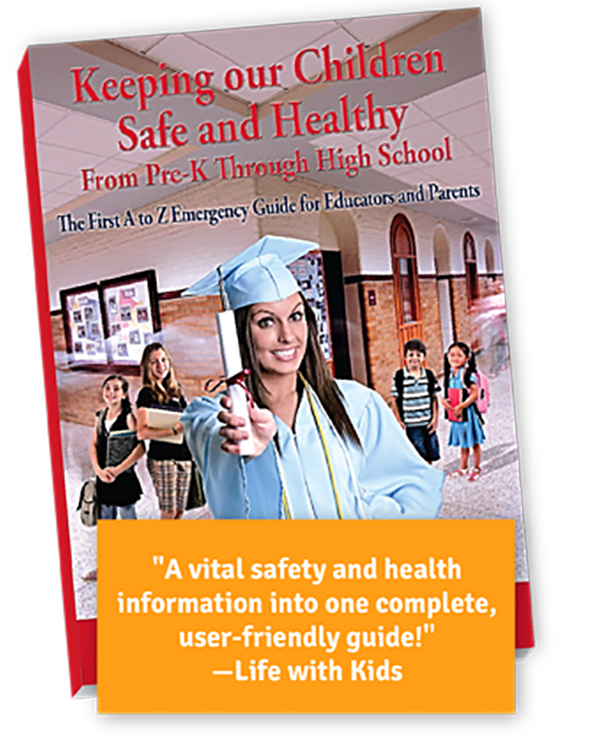MAKE SURE YOUR KIDS ARE PREPARED TO FACE BULLYING, HOSTAGE TAKING, STRANGER DANGER, etc.!
All these situations, and many more, are covered in this health and safety primer, in an easy-to-read format.
KEEPING OUR CHILDREN SAFE AND HEALTHY FROM PRE-K THROUGH HIGH SCHOOL
Paperback – 100 pages (full color)
ISBN: 978-0-9794652-0-8
By Albert David, Journalist, Specialized in Prevention and Safety Issues
§ Dr David Farcy, Director of the Emergency Department Critical Care in a Mount Sinai Medical Center

The First A to Z Emergency Guide For Educators and Parents!
Physical violence, verbal abuse, bullying, harassment, antisocial behavior, shootings… Every single day, our schools are center-stage for behaviors that stand against our social ethics. While the majority of such acts are committed among students, teachers are not spared from these habitual activities which instigate fear and impair the overall climate of our schools.
Who is to blame? Is it the family unit which, in case of dysfunction, struggles to channel and repress a child’s aggressive behavior or tendencies towards delinquency? Is it the psychological, medical, and social support systems which offer a helping hand, listen, and alleviate as well as they can without reaching and eradicating the root problems? Are television programs, movies, cell phones, and media such as the Internet responsible for swamping users with endless waves of violence and hatred?
Regardless of where the blame may or may not lie, school is and must remain an educational sanctuary that provides each and every student the same opportunities for achieving excellence.
Learning and knowledge are unlikely to be achieved without also teaching some kind of morality. How then is it possible to keep order, establish, and restore the school’s authority in an atmosphere of never-ending tension?
It’s time to make our schools safer !
Safety education is an incredible tool to help students become aware of their responsibilities when coping with hazards – physical, mental, and otherwise – in different areas of their lives. Safety education will also enable them to make decisions confidently and competently, introducing them to a lifestyle of respect, sharing, and solidarity.
To learn to protect and be protected, to rescue, to help others in times of danger, to confront fear, to act and not to be a victim, to understand that we are useful, able to extricate ourselves from difficult situations, to overcome adversity regardless of opinions, skin color, social origin, or learning difficulties – these are some of the skills which shape a student’s personality and character. These are some of the virtues which allow a student to develop dignity and honor.
The dangers that hover in and around our schools cannot be ignored. Our own children may be influenced by truancy, strangers, brutality, tobacco, alcohol and drug addiction, sexual abuse, and more. But, there is a way to limit these influences. Therefore, it is critical for students to learn how to react, to discuss social and moral issues, to talk about their fears to a school counselor, a psychologist, a relative, or a social worker, and set off alarm bells, if necessary.
Students must learn to recognize danger signs and know how to respond to a life-threatening situation, to say “No” to strangers and perpetrators, to ask or to call for help, and not to get entangled by peer pressure.
How do we teach children to be prepared against assaults, terrorism, and other unfamiliar contexts? How do we avoid tragedies? How do we teach children to understand a schoolmate’s apparently friendly behavior which then turns aggressive? When is the right time to report suspicious conduct?
The warnings and recommendations in this book about these topics—and many more—allow students to assess their own skills, and will help them, in the best possible way, to identify, prevent, and respond to safety and health issues in their daily environment.
More Than 1500 Safety Tips and Emergency First-Response Rules!
From A to Z, learn now how to react in case of any emergency!
How to call for help, Check the ABCs, Proceed to a CPR…
Acute Anxiety Disorder, Agitation, Alcohol intoxication, Asphyxia, Asthma attack, Back pain, Behavioral disorders, Bites (Insects, Animals), Carbon monoxide poisoning, Choking, Crushing, Dehydration, Dislocation, Dizziness, Drowning, Drug intoxication, Epileptic seizure, Eye burns, Fainting, Falls from a height, Food poisoning, Foreign bodies, Fractures, General discomfort, headache, Head injuries, Heart attack, Heat cramp, Heat, Exhaustion, Heat stroke, Heimlich maneuver, Hemorrhages, Hydrocution, Hyperglycemia, Hypoglycemia, Hypothermia, Impalement, Mental confusion, Muscle cramps, Nervous breakdown, Nose bleeds, Overdose, Panic attack, Scrapes, Seizures, Severed limbs and amputation, Shark attack, Shock, Sprain, Stings, Stomachache, Strangulation, Suffocation, Syncope, Thermal Burns, Tooth Loss, Toxic Poisoning (Poison ivy, Oak, Sumac), Vertigo, Wounds
